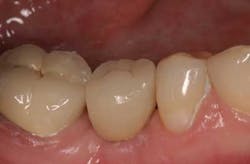Improving esthetics and periodontal health through orthodontic alignment
By Lauren Argentina, DDSAlthough orthodontic correction is usually perceived as a means of alleviating an esthetic issue, an adjunctive functional result of aligning teeth can be the improvement of a patient’s oral health. Many studies suggest that orthodontic improvement in teeth alignment can remove occlusal disharmonies, improve plaque traps, and enable patients to perform better oral hygiene.1Malpositioned teeth that are crowded, supra-erupted, in buccal/lingual version, and/or rotated can result in uneven contacts, tilted marginal ridges, areas of food impaction, and general malocclusion. The ability of the patient to perform adequate interproximal oral hygiene can become severely hindered by these problems and can result in deterioration of periodontal health.2 In addition, malocclusion can result in occlusal trauma, which has been identified as a co-contributor to the acceleration of periodontal deterioration.3,4Traditional orthodontic treatment of malpositioned teeth can often be accomplished with brackets and wires. Although quite effective, general practitioners may be hesitant to recommend traditional orthodontics to treat minor to moderate occlusal disharmony because of the perception of reduced case acceptance due to poor esthetics and long treatment times. Advances in esthetics in orthodontic therapy have increased case acceptance, especially among adults, and include the use of clear-colored wires and brackets, computer-generated removable aligner trays, and six-month smile technology. These newer approaches enable clinicians to conduct minor to moderate tooth movement without the drawbacks of traditional orthodontics. Here is a case example using one of these new technologies.Case studyThis 22-year-old female presented with the chief complaint of "crooked teeth” (Figs. 1 and 2). She was not interested in wearing traditional braces, and with aligner technology alone, it would have been very difficult to rotate No. 23 without a bracket on the tooth (Figs. 3 and 3a).
Fig. 1
Fig. 2
Fig. 3
Fig. 3aThe patient opted to proceed with Six Month Smiles®, a technique that employs the latest technology and techniques in dentistry to move teeth quickly and safely. The key components of the treatment are the use of special nickel titanium wires and barely visible tooth-colored wires and braces. Using low forces to move teeth comfortably while utilizing standard orthodontic mechanics, special emphasis is placed on proper movement with maximum esthetic results (Fig. 4).
Fig. 4By focusing our efforts on the teeth that are easier to move, we can both limit the time needed in braces and address what our patient's chief complaints usually are — the teeth that can be seen in their smiles. While this patient’s chief complaint of esthetic crowding was addressed (Figs. 5 and 6), she also noticed that her ability to perform interproximal oral hygiene was highly improved, which lead to less inflammation and her “gums bleeding a lot less” (Fig. 7).
Fig. 5
Fig. 6
Fig. 7Author bioDr. Lauren Argentina maintains a general dental practice in Port Jefferson, N.Y., with a focus on cosmetic dentistry and Six Month Smiles® Cosmetic Braces. Dr. Argentina received her BA from SUNY Stony Brook and her DDS degree from SUNY Stony Brook School of Dental Medicine. She completed a General Practice Residency at Stony Brook University Hospital. Dr. Argentina belongs to the American Dental Association, New York State Dental Association, Suffolk County Dental Society, American Academy of Cosmetic Dentistry, American Association of Women Dentists, Academy of General Dentistry, International Congress of Oral Implantologists, and the Academy of Comprehensive Esthetics. Each of these memberships gives her the ability to continually learn the newest information and best techniques in dentistry from her colleagues, and therefore the ability to provide her patients with the most comprehensive and complete treatment.References1. Ainamo J. Relationship between malalignment of the teeth and periodontal disease. European Journal of Oral Sciences. 1972; 80:104-110. doi: 10.1111/j.1600-0722.1972.tb00270.2. Ingervall B, Jacobsson U, Nyman S. A clinical study of the relationship between crowding of teeth, plaque, and gingival condition. Journal of Clinical Periodontology. 1977; 4:214-222. doi: 10.1111/j.1600-051X.1977.tb02275.3. Harrel SK. Occlusal forces as a risk factor for periodontal disease. Periodontol 2000. 2003; 32:111-117.4. Harrel SK, Nunn ME. The association of occlusal contacts with the presence of increased periodontal probing depth. J Clin Perio. 2009; 36:1035-1042.



